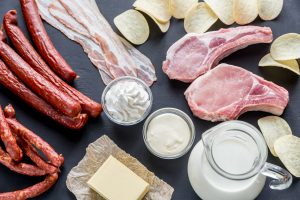
Good Fats & Bad Fats
Good Fats & Bad Fats
The nutrition story around fat used to be pretty simple: saturated fat were the fats, and polyunsaturated fat were the fat. But the story is a bit more complicated. Now we’re talking about getting the right balance of fat. Two kinds of polyunsaturated fat in particular: omega-3 and omega-6.
First, a little terminology. The terms omega-3 and omega-6 refer to the chemical structure of the fatty acid, and there are several omega-3 and omega-6 fatty acids that we eat, not just one. It’s not that either of these groups of fat is bad. In fact, within each group, there are ‘essential’ fatty acids—ones we need to eat, because our bodies can’t make them. In small amounts and in the right balance, essential fatty acids serve to support growth, vision and brain function.

The problem is that the balance in our diet is way off. Our food supply is overloaded with omega-6 fats, and we don’t get enough omega-3. And when the balance is off, our health may suffer.
It wasn’t always this way. The diet our ancient ancestors ate had just the right balance of fatty acids from all the plant foods they ate, like vegetables, fruits, nuts, and seeds.
While they don’t seem> fatty, all plant foods contain traces of both essential fatty acids. And it’s been estimated that this hunter-gatherer diet contained roughly the same amounts of omega-6 and omega-3 fatty acids—or a balance of about one-to-one.
In the last 150 years or so, our food supply has changed so much that we now eat about 15 times more omega-6 fats than omega-3s, which throws the ideal balance way off. One of the biggest contributors to this imbalance is the huge amount of grain-based oils we eat—particularly corn oil, which is one of the richest sources of omega-6 fats.
We’re overloaded with omega-6, which is in everything from fried foods, baked goods, chips, salad dressings, and sweets. At the same time, we’re not eating nearly enough omega-3s—particularly from fish—but also from foods like vegetables and nuts, too.
Good Fats & Bad Fats
Simply reducing the total amount of fat you eat will help to shift the balance, since most of the fatty foods we eat are the primary sources of omega-6 in the diet. Then to be sure you get fats that are good, try to eat more fish if you can. If you don’t cook it often, start with canned tuna or salmon, which can be used in a lot of dishes in place of poultry, like casseroles and pasta. If you can’t get fish on the menu a few times a week, you might want to consider a fish oil supplement.
Veggies and fruits naturally have the right balance of fatty acids, so do your best to include some at every meal. Fruits have fat mostly in their seeds, so those with edible seeds—like berries and kiwi—are great sources of these healthy fats. Think about nuts and seeds for snacks, too. They’re a great substitute for chips and crackers that can be full of the less healthy omega-6.
When it comes to dietary fat, what matters most is the type of fat you eat. Contrary to past dietary advice promoting low-fat diets, newer research shows that healthy fats are necessary and beneficial for health.
- When food manufacturers reduce fat, they often replace it with carbohydrates from sugar, refined grains, or other starches. Our bodies digest these refined carbohydrates and starches very quickly, affecting blood sugar and insulin levels and possibly resulting in weight gain and disease.
- Findings from the Nurses’ Health Study and the Health Professionals Follow-up Study show that no link between the overall percentage of calories from fat and any important health outcome, including cancer, heart disease, and weight gain.
Rather than adopting a low-fat diet, it’s more important to focus on eating beneficial “good” ones and avoiding harmful “bad” fats. Fat is an important part of a healthy diet. Choose foods with “good” unsaturated fat, limit foods high in saturated fat, and avoid “bad” trans fat.
- “Good” unsaturated fat — Monounsaturated and polyunsaturated fats — lower disease risk. Foods high in fats include vegetable oils (such as olive, canola, sunflower, soy, and corn), nuts, seeds, and fish.







